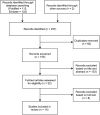COVID-19 and male reproduction: Current research and unknown factors
- PMID: 33427404
- PMCID: PMC8013647
- DOI: 10.1111/andr.12970
COVID-19 and male reproduction: Current research and unknown factors
Abstract
Background: The testes are suspected target organs of SARS-CoV-2. However, the results of studies on the effect of COVID-19 on male reproduction are controversial.
Objective: To summarize current research on the effects of COVID-19 on male reproduction.
Methods: A systematic review of English literature was performed using PubMed and Ovid Embase up to 18 August 2020. Research articles on the presence of SARS-CoV-2 in semen, the effects of the virus on semen parameters and any pathological changes in the testes were evaluated.
Results: Fourteen studies were included in this review. Six of 176 survivors (3.4%) and 1 of 13 decedents (7.7%) in 2 of 12 studies were positive for viral RNA in semen and testicular tissue, respectively. After stratification of patient groups, we found that the virus was detected in the relatively early stage of infection, 6-16 days after disease onset, in semen from survivors. Two of 3 studies reported that some participants had substandard semen quality after COVID-19, and 1 study found that COVID-19 may impair semen quality in a severity-related manner. Pathological analyses showed that injuries to the seminiferous tubule occurred in all decedents (N = 11). Another study found that orchitic and testis fibrin microthrombi occurred in patients with fatal disease (100%, N = 2). Scrotal discomfort of orchiepididymitis or spermatic cord inflammation has also been reported in COVID-19 patients.
Conclusion: Current studies suggest that semen is rarely considered a carrier of SARS-CoV-2 genetic material during the infection period but not in the semen of recovered patients. Fatal COVID-19 may cause testicular structure damage without the presence of virus.
Keywords: COVID-19; SARS-CoV-2; male reproduction; semen; testis.
© 2021 American Society of Andrology and European Academy of Andrology.
Conflict of interest statement
None.
Figures
Similar articles
-
Effect of COVID-19 on Male Reproductive System - A Systematic Review.Front Endocrinol (Lausanne). 2021 May 27;12:677701. doi: 10.3389/fendo.2021.677701. eCollection 2021. Front Endocrinol (Lausanne). 2021. PMID: 34122351 Free PMC article.
-
SARS-CoV-2 in the semen: Where does it come from?Andrology. 2021 Jan;9(1):39-41. doi: 10.1111/andr.12839. Epub 2020 Jul 28. Andrology. 2021. PMID: 32533891 Free PMC article. Review.
-
[SARS-CoV-2 infection: implications for sexual and reproductive health. A position statement of the Asociación Española de Andrología, Medicina Sexual y Reproductiva (ASESA)].Rev Int Androl. 2020 Jul-Sep;18(3):117-123. doi: 10.1016/j.androl.2020.06.001. Rev Int Androl. 2020. PMID: 32660697 Free PMC article. Spanish.
-
No detection of SARS-CoV-2 from urine, expressed prostatic secretions, and semen in 74 recovered COVID-19 male patients: A perspective and urogenital evaluation.Andrology. 2021 Jan;9(1):99-106. doi: 10.1111/andr.12939. Epub 2020 Nov 23. Andrology. 2021. PMID: 33150723
-
Evaluating the impact of COVID-19 on male reproduction.Reproduction. 2021 Feb;161(2):R37-R44. doi: 10.1530/REP-20-0523. Reproduction. 2021. PMID: 33434886 Review.
Cited by
-
Vulnerability of The Male Reproductive System to SARS-CoV-2 Invasion: Potential Role for The Endoplasmic Reticulum Chaperone Grp78/HSPA5/BiP.Cell J. 2022 Aug 28;24(8):427-433. doi: 10.22074/cellj.2022.8312. Cell J. 2022. PMID: 36093801 Free PMC article.
-
Oocyte Retrieval in Asymptomatic Patients Positive for SARS-CoV-2.Case Rep Obstet Gynecol. 2022 Aug 12;2022:3107747. doi: 10.1155/2022/3107747. eCollection 2022. Case Rep Obstet Gynecol. 2022. PMID: 35990707 Free PMC article.
-
Metabolic, Oxidative and Psychological Stress as Mediators of the Effect of COVID-19 on Male Infertility: A Literature Review.Int J Environ Res Public Health. 2022 Apr 26;19(9):5277. doi: 10.3390/ijerph19095277. Int J Environ Res Public Health. 2022. PMID: 35564672 Free PMC article. Review.
-
Coronavirus disease 2019 vaccination and infertility treatment outcomes.Fertil Steril. 2022 Jun;117(6):1291-1299. doi: 10.1016/j.fertnstert.2022.02.025. Epub 2022 Feb 25. Fertil Steril. 2022. PMID: 35437147 Free PMC article.
-
The impact of COVID-19 on the male reproductive tract and fertility: A systematic review.Arab J Urol. 2021 Aug 9;19(3):423-436. doi: 10.1080/2090598X.2021.1955554. eCollection 2021. Arab J Urol. 2021. PMID: 34552795 Free PMC article. Review.
References
-
- WHO . Coronavirus disease (COVID‐2019) situation reports. https://www.who.int/docs/default‐source/coronaviruse/situation‐reports/2... August 18, 2020.
-
- Douglas GC, O'Bryan MK, Hedger MP, et al. The novel angiotensin‐converting enzyme (ACE) homolog, ACE2, is selectively expressed by adult Leydig cells of the testis. Endocrinology. 2004;145(10):4703‐4711. - PubMed
Publication types
MeSH terms
Grants and funding
LinkOut - more resources
Full Text Sources
Other Literature Sources
Medical
Miscellaneous


